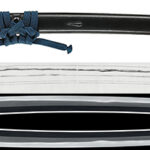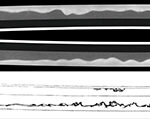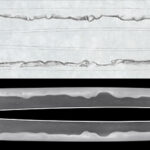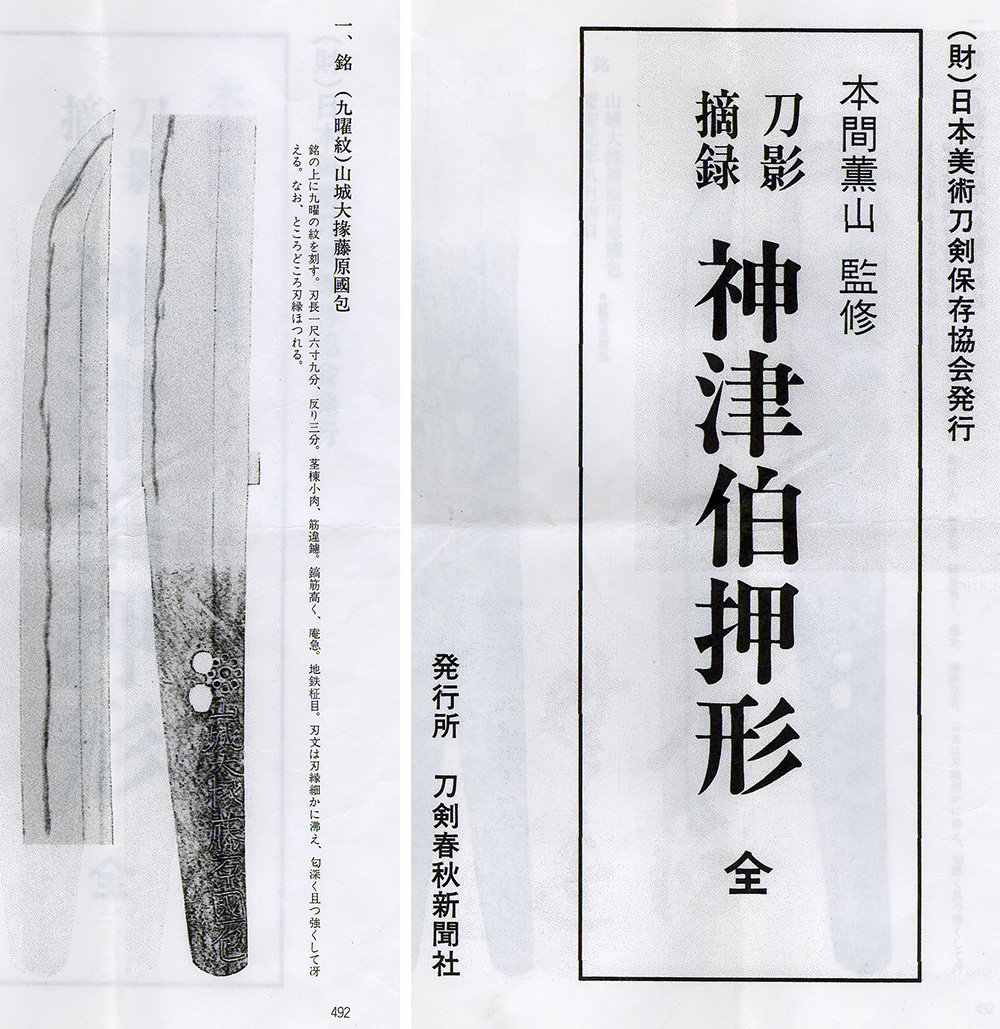Ordering number:AS24540
Wakizashi: In Shirasaya with Koshirae (NBTHK Tokubetsu Hozon Token) (Consignment Sale)
Signature: (Kuyo-mon) Yamashiro Daijo Fujiwara Kunikane
(First Generation)
(九曜紋)山城大掾藤原國包(初代)
Sayagaki: Yamashiro Daijo Fujiwara Kunikane
Above the signature is the Kuyomon crest
Hamon: 1 shaku 6 sun 9 bu 5 rin
Early autumn of Showa 23
Fumikou Kao
Shinto: Saijo O Wazamono: Saijo Saku: Rikuzen
(We divide 4 sections for each sword as Saijyo Saku, Jyojyo Saku, Jyo Saku, and Regular Saku.)
This sword is ranked as Saijo Saku as a work of Kunikane.
Polished.
Habaki: Gold-plated double habaki
Blade Length: 1 shaku 6 sun 9 bu (51.2 cm / 20.16 in)
Curvature: 3 bu (0.91 cm / 0.36 in)
Mekugi Holes: 2
Width at Base: 2.97 cm (1.17 in)
Width at Tip: 2.12 cm (0.83 in)
Thickness: 0.68 cm (0.27 in)
Sword Weight: 510 grams
Era: Kanei Era, Edo Period(1624)
Shape: The sword has a wide body, deep curvature, and an extended tip, presenting an excellent shape.
Jigane: The masame-hada is tight and well-forged, with chikei working well, resulting in a refined jigane.
Hamon: A nie-deki hamon with a deep nioiguchi, the blade is bright and clear, forming a double and even triple blade with soft ko-ashi entering the blade, and the boshi is yakitsume.
Features: This work features the Kuyomon crest above the signature, which is quite rare and unique. Moreover, this sword was exhibited at the Tokyo National Museum (with an exhibition deposit certificate attached, showing it was loaned from June 25, 2009, to December 31, 2011). It is also featured in a publication supervised by Honma Kunzan and issued by the NBTHK (p. 492). The famous craftsman Kunikane of the Sendai domain is noted to have engraved the Kuyomon on the tang, making this a highly valuable piece. This sword was registered as a daimyo sword on March 13, Showa 26 (1951). The registration certificate, numbered Ibaraki 2092, remains in pristine condition.
Koshirae:
Tsuba: Almost circular iron tsuba engraved with a wave design. Signature: Bushu Ju Akasaka Tadatoshi Saku
Fuchikashira: Fuchi and Kashira (made of shibuichi) with a wave and spray design depicted in gold
Saya: Black lacquered stone-patterned saya
Menuki: High-relief carving of a lion with gold inlay
Kozuka: A heron standing under a willow tree, engraved on brass. Signature: Yasuchika
Aoi Art's Comment: Kunikane, a resident of Sendai Castle town and descendant of Hojo Sadamune, initially went by the name Genzo and later changed his name to Hongo Yoshinaga. Under the orders of Date Masamune, he traveled to the capital and became an apprentice of Echizen no Kami Masatoshi. After the Siege of Osaka in Genwa 1 (1615), he returned to his home and resumed swordsmithing, re-entering Masatoshi’s school in Genwa 2. In Genwa 5, he completed his training and returned home, receiving the title of Yamashiro Daijo in Kanei 3. In Kanei 15, he entered the priesthood, taking the name Yokei. He passed on his workshop to his son, Yoshizaemon, in Shoho 2, retiring in Kanbun 4 at the age of 73. This is truly an extraordinary and luxurious work by the first-generation Kuyomon Yamashiro Daijo Fujiwara Kunikane. The masame grain is beautifully visible, with excellent chikei activity and a deep nioiguchi. It was exhibited at the Tokyo National Museum and is also featured in the NBTHK’s Honma Kunzan-supervised publication.
NBTHK Tokubetsu Hozon Token Certificate
Aoi Art Appraisal and Whole Oshigata
Auction Starting Price:2,400,000JPY
This item was sold at the auction
Related Items:
 Wakizashi:Soshu Ju Ise Daijo Fujiwara Tsunahiro(Hozon Token, Tokubetsu Kicho Token)
Wakizashi:Soshu Ju Ise Daijo Fujiwara Tsunahiro(Hozon Token, Tokubetsu Kicho Token)
 Wakizashi: Omi Daijo Fujiwara Tadahiro(NBTHK Tokubetsu Hozon Token)
Wakizashi: Omi Daijo Fujiwara Tadahiro(NBTHK Tokubetsu Hozon Token)
 Daisho:Tame Minobe Akihide Shi Chikushu Sanno Ju Sotsutomu Saku Showa 60 Nen 8 Gatsu Kichijitsu (August 1985)(NBTHK Hozon Token)
Daisho:Tame Minobe Akihide Shi Chikushu Sanno Ju Sotsutomu Saku Showa 60 Nen 8 Gatsu Kichijitsu (August 1985)(NBTHK Hozon Token)
 Wakizashi :Dewa Daijo Fujiwara Kunimichi
Wakizashi :Dewa Daijo Fujiwara Kunimichi
 Wakizashi:Echizen Ju Kawachi Daijo Fujiwara Yoshiue(NBTHK Hozon Token)
Wakizashi:Echizen Ju Kawachi Daijo Fujiwara Yoshiue(NBTHK Hozon Token)
 Wakizashi: Yamashiro Daijyo Minamoto Kunishige
Wakizashi: Yamashiro Daijyo Minamoto Kunishige









